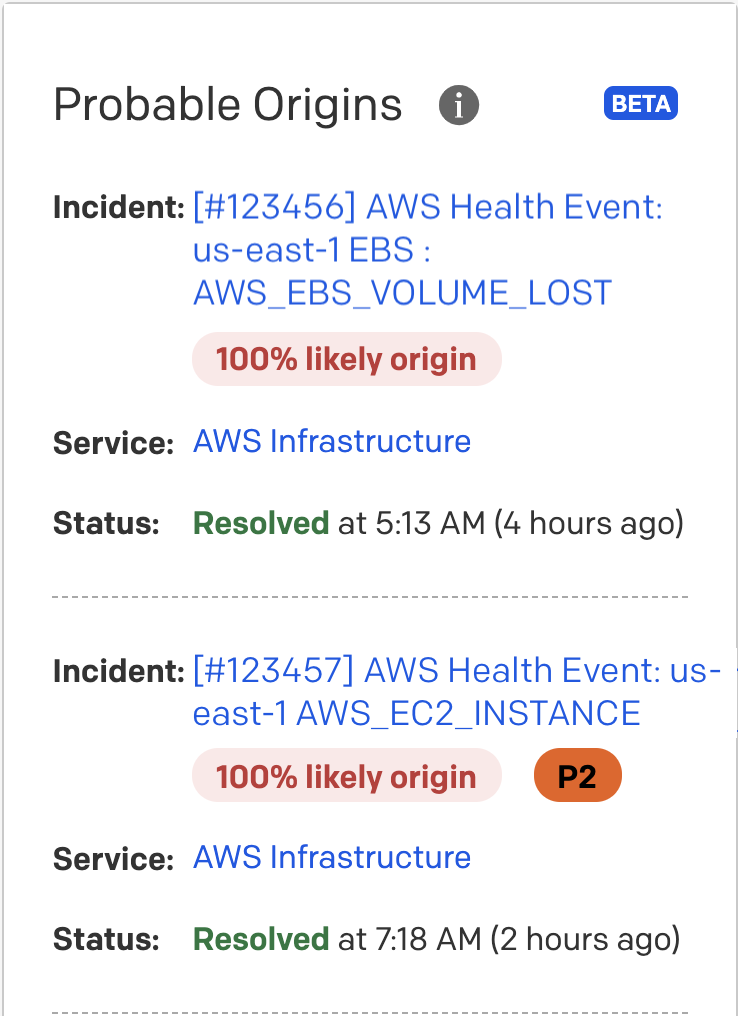Probable Origin
View incidents that are possible origins of the issue being investigated
Probable Origin provides incident responders with suggestions of incidents and services that are likely to be the origin point of the incident currently under investigation. This feature uses data science techniques to analyze past patterns over the prior six months to recognize when a recurring pattern of cascading incidents takes place. Viewing the suggested services and incidents, responders can map impact radius and quickly get to an incident origin point. This ensures that the right team is brought to the response rapidly, reducing the need for swarming and elimination processes, and freeing up resources on unconnected services.
Availability
This feature is available with our PagerDuty AIOps add-on, or with Legacy Event Intelligence. If you would like to sign up for a trial of PagerDuty AIOps features, please read PagerDuty AIOps Trials.
View Probable Origin in the Web App
- From the Incidents page or a service’s detail page, click your desired incident’s Title to see its detail page.
- If results are available, a Probable Origin card on the right side of the screen will display up to three suggested origin incidents.

View Probable Origin
Suggested incidents are ordered by the likelihood of a connection to the current incident being investigated. Likelihood is determined by how often the suggested incident occurred immediately before an incident similar to the primary incident.
Probable Origin Fields
- Incident: A link to the Probable Origin incident, the likelihood that the incident was the origin of the incident currently under investigation, and the Probable Origin incident's priority (if applicable).
- Service: A link to the service that the Probable Origin incident was on.
- Status: The status of the Probable Origin incident with timestamp information.
FAQ
Will every incident have Probable Origin suggestions available?
Expand
No, not every incident will have Probable Origin results. Past occurrence patterns determine Probable Origin suggestions. If a particular incident has not typically occurred in a similar pattern with other incidents, no Probable Origin suggestions will be displayed.
As a new PagerDuty customer, when will Probable Origin suggestions appear for me?
Expand
For existing PagerDuty customers that purchase the AIOps add-on, or the Enterprise for Incident Management or Digital Operations (Legacy) plans, Probable Origin suggestions will be available immediately, based on incident data from the past six months. For new PagerDuty customers, Probable Origin results will not be immediately available, since we rely on historical incident patterns to provide recommendations. The time required to start producing recommendations will depend on your incident volume. For customers with large volumes of incident data, expect suggestions within the first month of using PagerDuty.
How is Probable Origin different from Related Incidents?
Expand
Probable Origin and Related Incidents provide complementary information to help form a full picture of the impact radius of an incident. Related Incidents uses real-time machine learning and service dependency data to find correlated incidents that are actively impacting other responders and PagerDuty services. Related Incidents uses alert metadata to determine if incidents are related. In contrast, Probable Origin uses occurrence pattern data to determine when one incident may have caused the incident under investigation. Related Incidents suggests incidents that have occurred on any service, except the service with the incident that is actively being viewed. Probable Origin suggests incidents that have occurred on any service, including the service with the incident that is actively being viewed.
Updated 1 day ago
